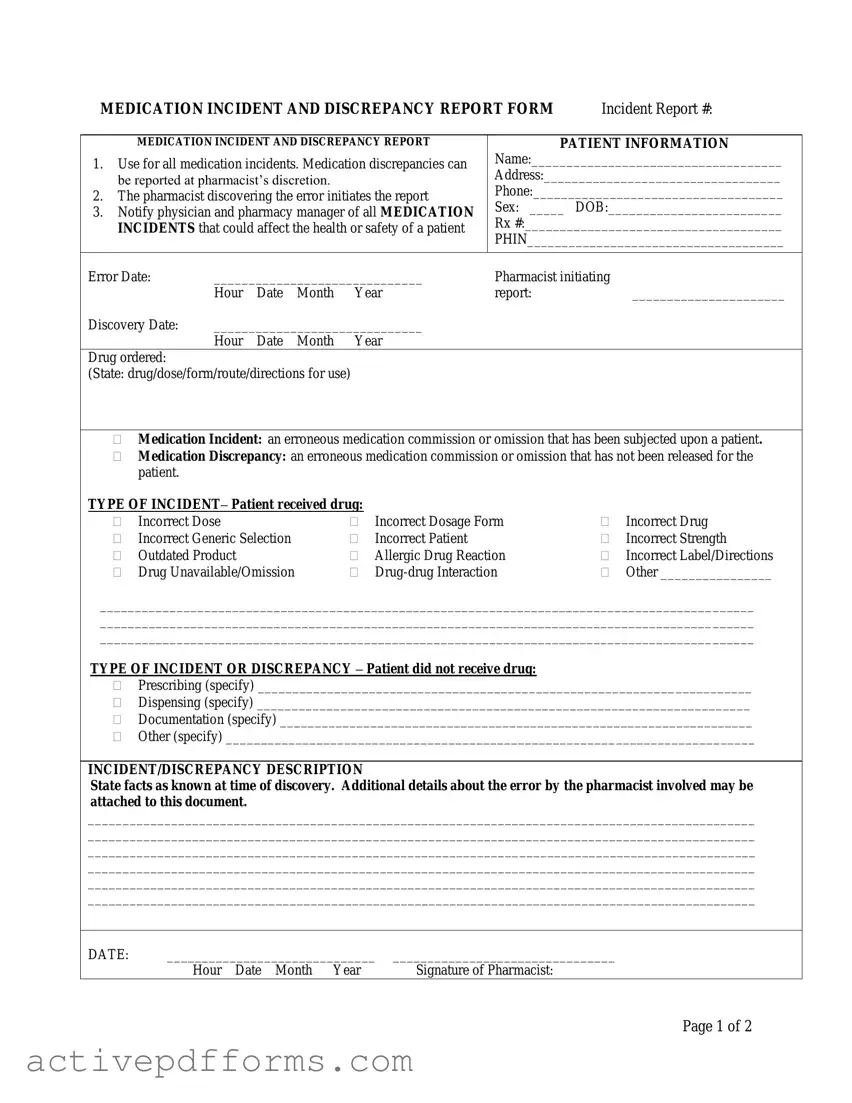Filling out a Medication Error form is a crucial step in addressing and preventing medication errors within a healthcare setting. Below are answers to some common questions that can help guide you through this important process.
- What is a Medication Error form?
This form is a documented report designed for use in scenarios where a medication incident or a discrepancy occurs. It's a systematic way to record the specific details of the incident, including the nature of the error, the medication involved, patient information, and the steps taken after discovering the error. The form serves multiple purposes: it ensures the patient's safety, allows for a review of the error to prevent future incidents, and complies with regulatory and quality standards.
- When should the Medication Error form be used?
It should be used in all cases of medication incidents, which are errors in medication administration that have affected a patient, and for medication discrepancies, which are errors that were caught before reaching the patient. Whether the issue arose during prescribing, dispensing, documenting, or adminистering the medication, it's essential to initiate the report.
- Who is responsible for filling out this form?
The pharmacist who discovers the medication error is primarily responsible for initiating and completing the form. They will include details such as the type of incident, patient information, the discovery date, and a description of the error. Additionally, they must detail any contributing factors to the error and the steps taken to notify the relevant parties, including the patient and the physician.
- What types of incidents should be reported on this form?
- Incorrect dose, dosage form, drug, or strength prescribed or dispensed.
- Errors in patient identification or in selecting the correct generic alternative.
- Administration of an outdated product or an incorrect label/directions.
- Failures to provide the drug due to unavailability or a significant drug-drug interaction.
- Any other discrepancies or incidents not specifically mentioned.
- What happens after the Medication Error form is filled out?
After completing the form, the pharmacist must sign and date it, then notify the pharmacy manager and the patient's physician as per the Standards of Practice. The severity of the incident is assessed, and an investigation follow-up identifies the problem, establishes a resolution, and implements measures to prevent recurrence. This could include changes in policy, procedure, knowledge, or awareness regarding the medication error.
- Is patient notification mandatory after a medication error?
Yes, notifying the patient is a critical step in the process. It’s important for maintaining trust and transparency in the healthcare setting. The form includes a section to document that the patient was informed about the error, including the specific date and time of notification. Depending on the error's severity, the explanation will vary, but honesty is paramount while ensuring the patient understands the mistake and its implications for their health.
- How does the use of the Medication Error form improve patient safety?
Using the form not only addresses the specific incident at hand by rectifying the error and mitigating any potential harm to the patient, but it also serves a broader purpose. By analyzing medication errors and discrepancies systematically, healthcare providers can identify patterns or systemic issues contributing to these errors. Consequently, this leads to the development of stronger, more effective policies and procedures, enhancing the overall safety and quality of patient care.


